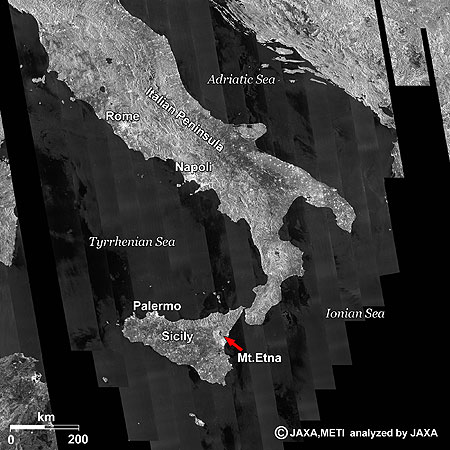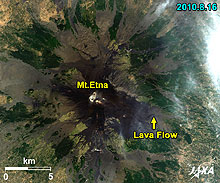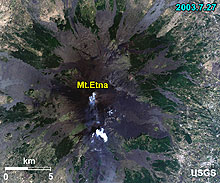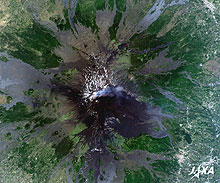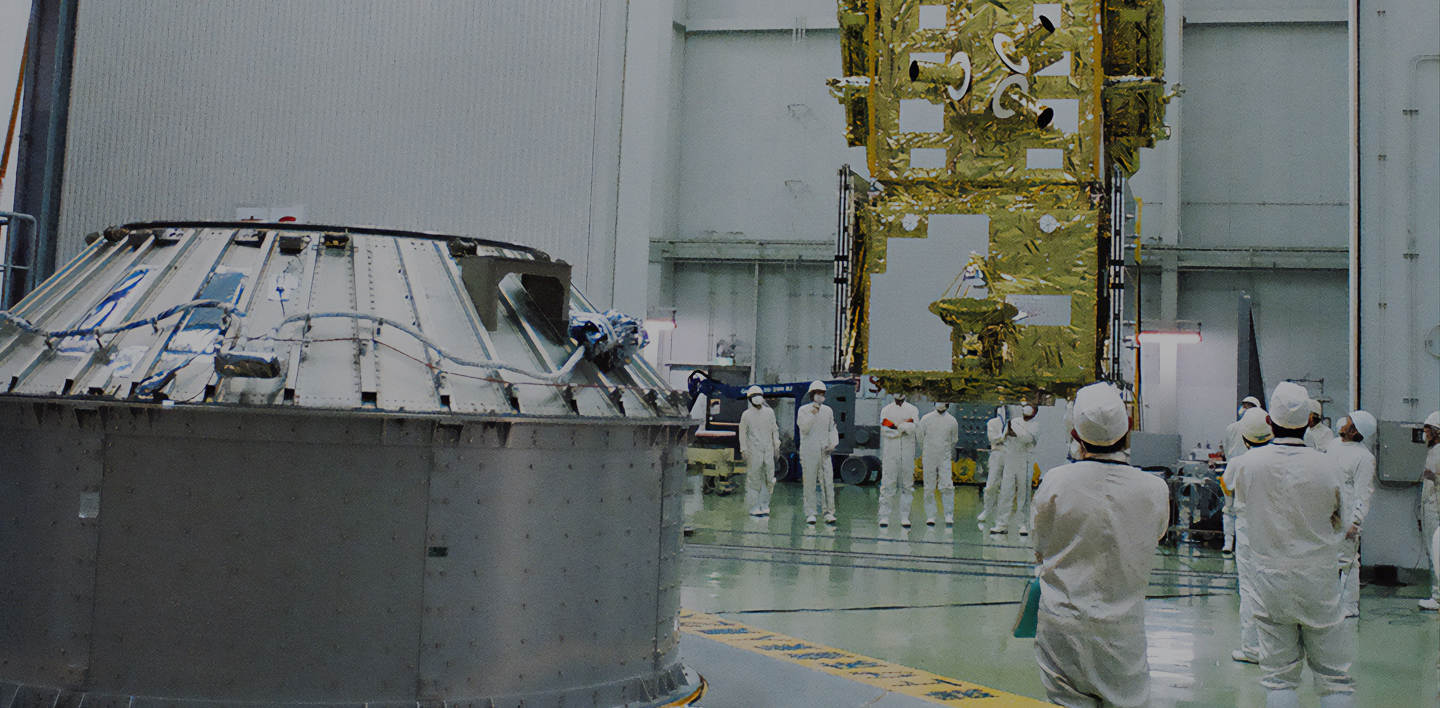

Latest Observation
2011.02.02 Wed
Sicily and Mt. Etna
Figure 1 is a mosaic radar image of the Italian Peninsula and Sicily taken by ALOS (“Daichi”) from June 12 to July 27, 2009. In general, ground objects reflecting radar signals strongly look bright. The cities of Rome and Napoli are such cases, as seen in the figure.
Sicily looks like a stone being kicked by the toe of the boot-shaped Italian Peninsula. Sicily is the largest island in the Mediterranean Sea. About 5 million people live on the island, which has an area of 25,000 km2. Palermo, the capital of the autonomous region of Sicily, appears bright on the northwestern coast of the island.
Sicily was the theater where many powers struggled for hegemony. There were wars between the colonial cities of Greece. Rome and Carthage fought there in the pre-Christian era. In the Christian era, Muslims ruled, Normans invaded, and then the Holy Roman Empire and Spanish Habsburg governed the island. In the nineteenth century, Sicily became a part of the Kingdom of Italy.
Figure 2 is an enlarged image of northern Sicily. The Strait of Messina separates the mainland and Sicily. Mt. Etna is located in the lower left of the image. The northern tip of Sicily facing the strait looks like a beak. The bright area under the beak is Messina, the third largest city in Sicily. A bridge over the strait is planned to be completed in 2016, and will surpass the Akashi Strait Bridge in Japan as the world’s longest cable-suspended bridge.
caption on
caption off
Mt.Etna (kmz, 6.87 MB, Low Resolution) as seen on Google Earth.
Figure 3 is three enlarged images of Mt. Etna taken by ALOS (“Daichi”) in August 2010 and June 2007, and by Landsat in July 2003. Volcanic fumes in the 2007 and 2003 images and traces of lava flow in the bluish part are visible in the images. Mt. Etna is the largest active volcano in Europe at 3,300 meters high, though this varies with summit eruptions. Mt. Etna has erupted many times. The lava flows in the 1669 and 1928 eruptions destroyed the villages at the foot of the mountain. Another large lava flow from an eruption in 1928 led to the destruction of a popular center. Other major eruptions occurring in 1971 buried the Etna observatory (built in the late 19th century) and destroyed the cable car. The arrows in the 2010 and 2007 images indicate the tips of new lava flow.
The fertile volcanic soil supports extensive agriculture with vineyards and orchards present around the foot of the mountain. Due to recent destructive eruptions occurring in the proximity of populated areas, Mt. Etna has been designated one of the sixteen volcanoes worthy of regular observation. Mt. Fugendake in Unzen and Sakurajima Island in Japan are also included on the list.
Volcanoes in Active Phase in 2011
Mt. Shinmoedake (1,421 m) in the Kirishima Mountains in Japan exploded on January 27, 2011.
This was the first eruption since 1959. The Kagoshima Meteorological Observatory raised the alert level from 2 (the crater is inaccessible) to level 3 (the volcano is inaccessible). Before the Mt. Shinmoedake eruption, Mt. Etna erupted on January 12, 2011 and the lava flowed for 2 hours. There is a village near the mountain, but no injuries were reported.
Kyoto and Carbon Initiative Project
JAXA’s ALOS Research and Application Project has been implementing the ALOS Kyoto and Carbon Initiative. The objective of this initiative is to meet the requirements raised by the Kyoto Protocol and to share the data of Earth observation satellites. ALOS PALSAR mosaic images over continental scales are regularly generated and opened to the public. Figure 1 is one such product. Please see the Kyoto & Carbon Initiative page for more details.
Explanation of the Images:

| Satellite: | Advanced Land Observing Satellite (ALOS) (Daichi) |
| Sensor: | Phased Array type L-band Synthetic Aperture Radar (PALSAR)(Fig. 1) |
| Date: | June 12, 2009 – July 27, 2009 |
| Ground resolution: | 500 m (K&C 500 m Browse Mosaic Product) |
| Map Projection: | Universal Transversal Mercator (UTM) |
Figure 1 is a black and white PALSAR image. In general, smooth areas indicate water surfaces and blocky areas indicate land.
| Satellite: | Landsat-5 (USA) |
| Sensor: | Thematic Mapper (TM) |
| Date: | July 27, 2003 (Fig. 2 and Fig. 3) |
| Ground resolution: | 30 m |
| Map Projection: | Universal Transversal Mercator (UTM) |
The image data of Figures 2 and 3 are downloaded free of charge from the USGS Global Visualization Viewer (Glovis). The color composite images are produced by assigning red to Band 3 (630 to 690 nm), green to Band 2 (520 to 600 nm), and blue to Band 1 (450 to 520 nm). The resulting images have natural coloring as if seen by the naked eye.
| Satellite: | Advanced Land Observing Satellite (ALOS) (Daichi) |
| Sensor: | Advanced Visible and Near Infrared Radiometer-2 (AVNIR-2) |
| Date: | 00:56 (UTC) on August 16, 2010 (Fig. 2 and Fig. 3) 00:56 (UTC) on June 23, 2007 (Fig. 3) |
| Ground resolution: | 10 m |
| Map Projection: | Universal Transversal Mercator (UTM) |
AVNIR-2 has four observation bands. The color composite images are produced by assigning red to Band 3 (610 to 690 nm), green to Band 2 (520 to 600 nm), and blue to Band 1 (420 to 500 nm). The resulting images have natural coloring as if seen by the naked eye. Each color indicates the following ground objects:
| Dark green: | Forests |
| Bright green: | Grass fields |
| Brown: | Bare land |
| Blue: | Sea surface |
| White: | Road, buildings, or clouds |
関連サイト
- ALOS Research and Application Page
- K&C PALSAR 500 m Browse Mosaic Product
- Sakurajima and Kagoshima, Japan
- Seen from Space Category : Latest Observation
Port Town of the Golden Sun – Naples
The Eternal Capital with a Long History: Rome
A Cluster of Observatories on Volcanoes: The Island of Hawaii
Search by Year
Search by Categories
Tags
-
#Earthquake
-
#Land
-
#Satellite Data
-
#Aerosol
-
#Public Health
-
#GCOM-C
-
#Sea
-
#Atmosphere
-
#Ice
-
#Today's Earth
-
#Flood
-
#Water Cycle
-
#AW3D
-
#G-Portal
-
#EarthCARE
-
#Volcano
-
#Agriculture
-
#Himawari
-
#GHG
-
#GPM
-
#GOSAT
-
#Simulation
-
#GCOM-W
-
#Drought
-
#Fire
-
#Forest
-
#Cooperation
-
#Precipitation
-
#Typhoon
-
#DPR
-
#NEXRA
-
#ALOS
-
#GSMaP
-
#Climate Change
-
#Carbon Cycle
-
#API
-
#Humanities Sociology
-
#AMSR
-
#Land Use Land Cover
-
#Environmental issues
-
#Quick Report
Related Resources
Latest Observation Related Articles
-
 Latest Observation 2025.02.28 Fri The world’s largest iceberg, A23a, may have run aground on the continental shelf of South Georgia:
Latest Observation 2025.02.28 Fri The world’s largest iceberg, A23a, may have run aground on the continental shelf of South Georgia:
The trajectory of iceberg A23a observed by “GCOM-W”, “ALOS-2” and “ALOS-4” -
 Latest Observation 2024.11.06 Wed [Quick Report] Heavy rainfalls in eastern Spain, as seen by the Global Satellite Mapping of Precipitation (GSMaP)
Latest Observation 2024.11.06 Wed [Quick Report] Heavy rainfalls in eastern Spain, as seen by the Global Satellite Mapping of Precipitation (GSMaP) -
 Latest Observation 2024.10.11 Fri Antarctic Winter Sea Ice Extent Second lowest in Satellite History
Latest Observation 2024.10.11 Fri Antarctic Winter Sea Ice Extent Second lowest in Satellite History -
 Latest Observation 2024.10.08 Tue [Quick Report] Global sea surface temperature in September 2024 observed by AMSR2
Latest Observation 2024.10.08 Tue [Quick Report] Global sea surface temperature in September 2024 observed by AMSR2










